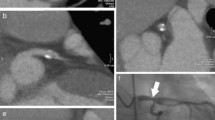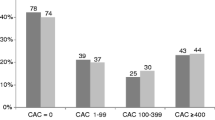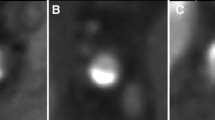Abstract
Electron-beam Computed Tomography (EBCT) has been used for years to quantify coronary artery calcification as a marker of coronary atherosclerosis. The aim of this study was to determine the diagnostic accuracy of a new scanner, the Multi-slice Spiral CT (MSCT), for the assessment of coronary calcification and to compare this new technique to EBCT. The study population consisted of 99 male patients, aged 60 ± 10 years with suspected or known coronary artery disease. With EBCT 40 axial slices, ECG-triggered (scan time = 100 ms, slice thickness = 3 mm), were acquired in one breath-hold (35 ± 5 s). For MSCT simultaneous acquisition of four axial slices (scan time = 250 ms, slice thickness = 2.5 mm), allowed the entire heart (48 slices) to be covered in one breath-hold of 25 ± 5 s. For quantification of coronary calcium the Volumetric Calcium Score (VCS) was calculated. There was an excellent correlation for the VCS (r = 0.994, p = 0.01, mean difference = 97 ± 115) between both scanners. Comparison of low (1–100), moderate (101–400), high (401–1000) and very high score values (>1000) showed no significant differences. The number of calcified lesions and densities were statistically not different. Mean variability of the two scans was 17%. The MSCT scanner is equivalent to EBCT for the determination and quantification of coronary calcium and can therefore be used for calcium screening. With application of the spiral mode technique further improvement in variability can be expected, thus allowing for follow-up studies to determine progression or regression of atherosclerosis with high accuracy.
Similar content being viewed by others
References
WHO Monica Project: Myocardial infarction and coronary deaths in the world health organization MONICA project. Registration procedures, event rates, and case-fatality rates in 38 populations from 21 countries in four continents. Circulation 1994; 90: 583–612.
Downs JR, Clearfield M, Weis S, et al. Primary prevention of acute coronary events with lovastatin in men and women with average cholesterol levels: results of AFCAPs/Tex-CAPS: Air Force/Texas Coronary Atherosclerosis Prevention Study. JAMA 1998; 279: 1615–1622.
Sheperd J, Cobbe SM, Ford I, et al. For the West of Scotland Coronary Prevention Study Group: Prevention of coronary heart disease with pravastatin in men with hypercholesterolemia. New Engl J Med 1995; 333: 1301–1307.
Mautner GC, Mautner SL, Froehlich J, et al. Coronary artery calcification; assessment with electron beam CT and histomonomorphic correlation. Radiology 1994; 192: 619–623.
Detrano R, Froelicher V. A logical approach to screening for coronary artery disease. Ann Intern Med 1987; 106: 846–852.
Rumberger JA, Simons DB, Fitzpatrick LA, Sheedy PF, Schwartz RS. Coronary artery calcium area by electron-beam computed tomography and coronary atherosclerotic plaque area. A histopathologic correlative study. Circulation 1995; 92: 2157–2162.
Shemesh J, Apter S, Rozenman J, et al. Calcification of coronary arteries: detection and quantification with double-helix CT. Radiology 1995; 197: 779–783.
Becker CR, Jakobs TF, Aydemir S, et al. Helical and single-slice conventional CT versus electron beam CT for the quantification of coronary artery calcification. Am J Roentgenol 2000; 174(2): 543–547.
Carr JJ, Crouse JR III, Goff DC Jr, D'Agostino RB Jr, Peterson NP, Bruke GL. Evaluation of subsecond gated helical CT for quantification of coronary artery calcium and comparison with electron beam CT. Am J Roentgenol 2000; 174(4): 915–921.
Ohnesorge B, Flohr T, Becker C, et al. Cardiac imaging by means of electrocardiographically gated multislice spiral CT: initial experience. Radiology 2000; 217(2): 564–571.
Knez A, Becker CR, Ohnesorge B, Haberl R, Reiser M, Steinbeck G. Noninvasive detection of coronary artery stenosis by multislice helical computed tomography. Circulation 2000; 101(23): E221–E222.
Callister TQ, Cooil B, Raya SP, Lippolis NJ, Russo DJ, Raggi P. Coronary artery disease: improved reproducibility of calcium scoring with an Electron-Beam CT volumetric method. Radiology 1998; 208: 807–814.
Bland JM, Altman DG. Statistical methods for assessing agreement between two methods of clinical measurement. Lancet 1986; 1: 307–310.
Breen JF, Sheedy PF II, Schwartz RS, Stanson AW, Kaufman RB, Moil PP. Coronary artery calcification detected with ultrafast CT as an indication of coronary artery disease. Radiology 1992; 185: 435–439.
Arad Y, Spadaro LA, Goodman K, Liedo-Perez A, Sherman S, Lerner G. Predicitive value of electron beam computed tomography of the coronary arteries: 19-month follow-up of 1173 asymptomatic subjects. Circulation 1996; 93: 1951–1953.
Fallovollita JA, Kumar K, Brody AS, Bunnell IL, Canty JM Jr. Detection of coronary artery calcium to differentiate patients with early coronary atherosclerosis from luminally normal arteries. Am J Cardiol 1996; 76: 1281–1284.
O'Rouke RA, Brundage BH, Froehlicher VF, et al. American College of Cardiology/American Heart Association Expert Consensus Document on Electron-Beam Computed Tomography for the Diagnosis and Prognosis of Coronary Artery Disease. Circulation 2000; 102: 126–140.
Rumberger JA, Brundage BH, Rader DJ, Kondos G. Electron beam computed tomographic coronary calcium scanning: a review and guidelines for use in asymptomatic persons. Mayo Clin Proc 1999; 74: 243–252.
Bielak LF, Kaufmann RB, Moll PP, Collough CH, Schwartz RS, Sheedy PF. Small lesions in the heart identified at electron beam CT: calcification or noise? Radiology 1994; 192: 631–636.
Yoon HC, Goldin JG, Greaser LE III, Sayre J, Fonarow GC. Interscan variation in coronary artery calcium quantification in a large asymptomatic patient population. Am J Roentgenol 2000; 174(3): 803–809.
Kajinami K, Seki H, Takekoshi N, Mabuchi H. Quantification of coronary artery calcification using ultrafast computed tomography: reproducibility of measurements. Coronary Artery Disease 1993; 4: 1103–1108.
Ohnesorge B, Flohr T, Becker C, et al. Herzbildgebung mit schneller, retrospektiver EKG-synchronisierter Mehrschichtspiral-CT. Radiologe 2000 40(2): 111–117.
Author information
Authors and Affiliations
Rights and permissions
About this article
Cite this article
Knez, A., Becker, C., Becker, A. et al. Determination of coronary calcium with Multi-slice Spiral Computed Tomography: a comparative study with Electron-beam CT. Int J Cardiovasc Imaging 18, 295–303 (2002). https://doi.org/10.1023/A:1015536705455
Issue Date:
DOI: https://doi.org/10.1023/A:1015536705455




